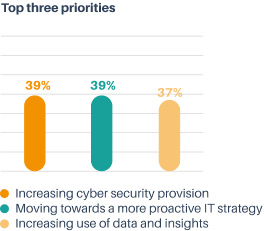The Fluid maturity framework is an overview of everything the non-technical IT director needs to consider when establishing or reviewing an IT function, from developing a proactive digital strategy to IT infrastructure and cyber security. There are eight business areas in the Framework - get these right and you’ve nailed it.
Opportunities
- Digital and IT strategy, change delivery and governance
- Business system capability and scalability
- Digital transformation enablement
- Business Intelligence, data and integration
Risks
- Cyber security and GDPR
- IT infrastructure, disaster recovery and resilience
- IT supplier capability and vendor management
- Software development, IT policies, IT operations and IT support
How to use the Fluid Maturity Framework
The framework gives you a simple way to benchmark your company's current level of digital and IT maturity, and agree a target maturity for the business. Many SMEs are at levels 1 or 2 in most areas, and in today’s increasingly digital world, they should be aiming for at least a level 3, and in most cases a level 4, in each of the eight competencies.
The target levels will depend on the business’s appetite for risk, growth plan, and drive to outpace competitors. By assessing your business against the IT Maturity Framework and setting your own targets, you’ll quickly get an understanding of your biggest gaps and have a sound basis for discussion about where to prioritise technology investments.
Tom Ainscough is the Ops and IT Director at ZyroFisher, a private equity-backed business and the leading distributor of parts, accessories and clothing to the UK and Irish cycling markets. Tom is a supply chain and operations specialist who took on the IT role as a layman. He engaged Fluid to deliver a 360 degree assessment of ZyroFisher’s IT provision and digital strategy, and to develop a digital and IT roadmap aligned to business outcomes, to support the business's value creation plan.
In March 2020 ZyroFisher pivoted to remote-working. Over the next 12-months they innovated their way through the Covid-19 crisis, upgrading their Enterprise and Resource Planning (ERP) system,
improved security and expanded from two to ten B2C websites.
Why now?
In 2020 the top technology priorities for UK SMEs were to mitigate risk, especially the threat of cyber attack, and develop opportunities for business growth with a digital strategy focussed on increasing visibility of internal data and using it for competitive advantage(1).
SMEs are driving business efficiencies and profitability by increasing the use of collaboration tools like Microsoft 365, increasing the adoption of cloud computing and investing in effective back up and disaster recovery solutions to ensure business continuity.


Like it or not, the fourth industrial revolution is already in train. Digital products and services once considered new are now mainstream. The top five technologies currently used by SMEs includes the Internet of Things, cyber security, data and analytics, digital transformation, and the cloud.
Digital and IT skills are at a premium as businesses compete to fill gaps in their team capability. In 2020 the top three technology concerns for SMEs included a lack of workers with digital know-how.
Lots of SMEs have no inhouse IT department. They couldn’t afford all the roles they would need and they wouldn’t they need them full time anyway. They also lack the time and capacity to think strategically about digital and to research new and emerging technology.
Too many SMEs are working with IT systems that fail to meet their core business requirements and they’re held back by manual processing and off-system workarounds. We’ve found lots of SME businesses are unable to hold their IT suppliers to account because they don’t have the requisite technical knowledge and experience.
Most SMEs are eager to develop a proactive digital and IT strategy, one that supports and enables business growth, streamlines operating models, and enables new digitally enhanced products and services.
.svg)
" I really appreciated getting a full picture, from an unbiased perspective, of exactly where the business was in terms of platforms, software and hardware, and the associated risks and opportunities.
It allowed me to make decisions about where to invest resource. And we were able to plan and prioritise the deliverables based on the benefits to the business."
Tom Ainscough , ZyroFisher
Ops and IT Director
Tom Ainscough is the Ops and IT Director at ZyroFisher, a private equity-backed business and the leading distributor of parts, accessories and clothing to the UK and Irish cycling markets. Tom is a supply chain and operations specialist who took on the IT role as a layman. He engaged Fluid to deliver a 360 degree assessment of ZyroFisher’s IT provision and digital strategy, and to develop a digital and IT roadmap aligned to business outcomes, to support the business's value creation plan.
In March 2020 ZyroFisher pivoted to remote-working. Over the next 12-months they innovated their way through the Covid-19 crisis, upgrading their Enterprise and Resource Planning (ERP) system,
improved security and expanded from two to ten B2C websites.
